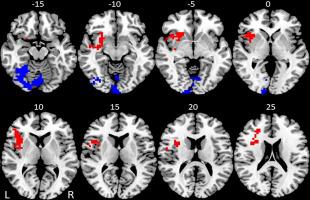NeuroImage: Clinical ( IF 4.2 ) Pub Date : 2020-05-26 , DOI: 10.1016/j.nicl.2020.102291 Sheut-Ling Lam 1 , Marion Criaud 1 , Analucia Alegria 1 , Gareth J Barker 2 , Vincent Giampietro 2 , Katya Rubia 1

|
Functional Magnetic Resonance Imaging Neurofeedback (fMRI-NF) targeting brain areas/networks shown to be dysfunctional by previous fMRI research is a promising novel neurotherapy for ADHD. Our pioneering study in 31 adolescents with ADHD showed that fMRI-NF of the right inferior frontal cortex (rIFC) and of the left parahippocampal gyrus (lPHG) was associated with clinical improvements. Previous studies using electro-encephalography-NF have shown, however, that not all ADHD patients learn to self-regulate, and the predictors of fMRI-NF self-regulation learning are not presently known. The aim of the current study was therefore to elucidate the potential predictors of fMRI-NF learning by investigating the relationship between fMRI-NF learning and baseline inhibitory brain function during an fMRI stop task, along with clinical and cognitive measures. fMRI-NF learning capacity was calculated for each participant by correlating the number of completed fMRI-NF runs with brain activation in their respective target regions from each run (rIFC or lPHG); higher correlation values were taken as a marker of better (linear) fMRI-NF learning. Linear correlations were then conducted between baseline measures and the participants’ capacity for fMRI-NF learning. Better fMRI-NF learning was related to increased activation in left inferior fronto-striatal regions during the fMRI stop task. Poorer self-regulation during fMRI-NF training was associated with enhanced activation in posterior temporo-occipital and cerebellar regions. Cognitive and clinical measures were not associated with general fMRI-NF learning across all participants. A categorical analysis showed that 48% of adolescents with ADHD successfully learned fMRI-NF and this was also not associated with any baseline clinical or cognitive measures except that faster processing speed during inhibition and attention tasks predicted learning. Taken together, the findings suggest that imaging data are more predictive of fMRI-NF self-regulation skills in ADHD than behavioural data. Stronger baseline activation in fronto-striatal cognitive control regions predicts better fMRI-NF learning in ADHD.
中文翻译:

与注意力缺陷/多动症青少年的fMRI-神经反馈学习相关的神经功能和行为测量。
以前的功能磁共振成像研究表明,针对大脑区域/网络的功能性磁共振成像神经反馈(fMRI-NF)是一种有望用于ADHD的新型神经疗法。我们在31名ADHD青少年中进行的开创性研究表明,右下额叶皮质(rIFC)和左海马旁回(lPHG)的fMRI-NF与临床改善有关。然而,先前使用脑电图-NF的研究表明,并非所有的ADHD患者都学会自我调节,而fMRI-NF自我调节学习的预测因子目前尚不清楚。因此,本研究的目的是通过调查fMRI停止任务期间fMRI-NF学习与基线抑制性脑功能之间的关系以及临床和认知措施,来阐明fMRI-NF学习的潜在预测因子。通过将完成的fMRI-NF运行次数与每次运行各自目标区域(rIFC或lPHG)中的大脑激活相关联,计算每个参与者的fMRI-NF学习能力;较高的相关值被认为是更好的(线性)fMRI-NF学习的标志。然后在基线量度与参与者的fMRI-NF学习能力之间进行线性相关。在fMRI停止任务期间,更好的fMRI-NF学习与左下额纹状体区域激活增加有关。fMRI-NF训练期间较差的自我调节与后颞枕和小脑区域的激活增强有关。在所有参与者中,认知和临床措施均与一般性fMRI-NF学习无关。一项分类分析显示,有48%的ADHD青少年成功学习了fMRI-NF,并且这与任何基线临床或认知指标均无关,只是抑制和注意任务期间更快的处理速度可以预测学习。综上所述,这些发现表明,与行为数据相比,影像数据对ADHD中fMRI-NF自我调节技能的预测性更高。额叶纹状体认知控制区域中较强的基线激活预示了ADHD中更好的fMRI-NF学习。


























 京公网安备 11010802027423号
京公网安备 11010802027423号